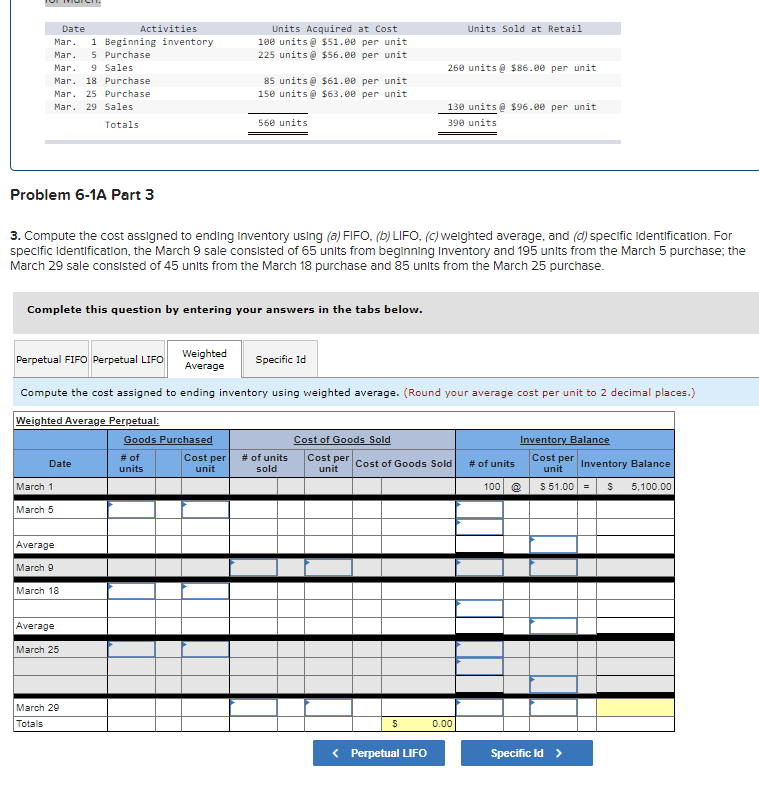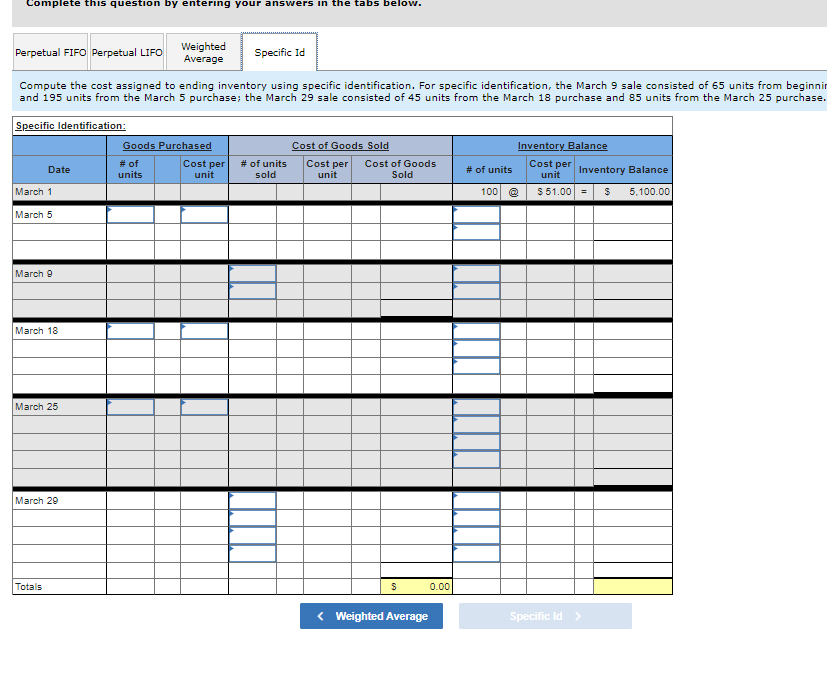Date Activities Mar. 1 Beginning inventory Mar. 5 Purchase Mar. 9 Sales Mar. 18 Purchase Mar. 25 Purchase Mar. 29 Sales Totals Problem 6-1A Part 3 Date Complete this question by entering your answers in the tabs below. March 1 March 5 Average March 9 March 18 3. Compute the cost assigned to ending Inventory using (a) FIFO, (b) LIFO, (c) weighted average, and (d) specific Identification. For specific Identification, the March 9 sale consisted of 65 units from beginning Inventory and 195 units from the March 5 purchase; the March 29 sale consisted of 45 units from the March 18 purchase and 85 units from the March 25 purchase. Average March 25 Units Acquired at Cost 100 units @ $51.00 per unit 225 units@ $56.00 per unit March 29 Totals 85 units @ $61.00 per unit 150 units @ $63.00 per unit Perpetual FIFO Perpetual LIFO Weighted Average Compute the cost assigned to ending inventory using weighted average. (Round your average cost per unit to 2 decimal places.) Weighted Average Perpetual: Goods Purchased 560 units # of units Specific Id Cost per # of units unit sold Cost of Goods Sold 260 units @ $86.00 per unit S Units Sold at Retail 130 units @ $96.00 per unit 398 units Cost per Cost of Goods Sold unit < Perpetual LIFO 0.00 # of units Inventory Balance Cost per unit Inventory Balance $ 51.00 = S 5,100.00 100 @ Specific Id >
Date Activities Mar. 1 Beginning inventory Mar. 5 Purchase Mar. 9 Sales Mar. 18 Purchase Mar. 25 Purchase Mar. 29 Sales Totals Problem 6-1A Part 3 Date Complete this question by entering your answers in the tabs below. March 1 March 5 Average March 9 March 18 3. Compute the cost assigned to ending Inventory using (a) FIFO, (b) LIFO, (c) weighted average, and (d) specific Identification. For specific Identification, the March 9 sale consisted of 65 units from beginning Inventory and 195 units from the March 5 purchase; the March 29 sale consisted of 45 units from the March 18 purchase and 85 units from the March 25 purchase. Average March 25 Units Acquired at Cost 100 units @ $51.00 per unit 225 units@ $56.00 per unit March 29 Totals 85 units @ $61.00 per unit 150 units @ $63.00 per unit Perpetual FIFO Perpetual LIFO Weighted Average Compute the cost assigned to ending inventory using weighted average. (Round your average cost per unit to 2 decimal places.) Weighted Average Perpetual: Goods Purchased 560 units # of units Specific Id Cost per # of units unit sold Cost of Goods Sold 260 units @ $86.00 per unit S Units Sold at Retail 130 units @ $96.00 per unit 398 units Cost per Cost of Goods Sold unit < Perpetual LIFO 0.00 # of units Inventory Balance Cost per unit Inventory Balance $ 51.00 = S 5,100.00 100 @ Specific Id >
Financial & Managerial Accounting
13th Edition
ISBN:9781285866307
Author:Carl Warren, James M. Reeve, Jonathan Duchac
Publisher:Carl Warren, James M. Reeve, Jonathan Duchac
Chapter6: Inventories
Section: Chapter Questions
Problem 6.3APR
Related questions
Topic Video
Question
Required information
Problem 6-1A Perpetual: Alternative cost flows LO P1
Skip to question
[The following information applies to the questions displayed below.]
Warnerwoods Company uses a perpetual inventory system. It entered into the following purchases and sales transactions for March.
Weighted Average Sheet and Specific ID Sheets

Transcribed Image Text:Date
Activities
Mar. 1 Beginning inventory
Mar. 5 Purchase
Mar. 9 Sales
Mar. 18 Purchase
Mar. 25 Purchase
Mar. 29 Sales
Totals
Problem 6-1A Part 3
Perpetual FIFO Perpetual LIFO
Complete this question by entering your answers in the tabs below.
Date
March 1
March 5
3. Compute the cost assigned to ending Inventory using (a) FIFO, (b) LIFO, (c) weighted average, and (d) specific identification. For
specific Identification, the March 9 sale consisted of 65 units from beginning Inventory and 195 units from the March 5 purchase; the
March 29 sale consisted of 45 units from the March 18 purchase and 85 units from the March 25 purchase.
Average
March 9
March 18
Weighted
Average
Compute the cost assigned to ending inventory using weighted average. (Round your average cost per unit to 2 decimal places.)
Weighted Average Perpetual:
Average
March 25
Units Acquired at Cost
100 units @ $51.00 per unit
225 units@ $56.00 per unit
March 29
Totals
85 units@ $61.00 per unit
150 units@ $63.00 per unit
Goods Purchased
560 units
# of
units
Specific Id
Cost per # of units
unit
sold
Cost of Goods Sold
Cost per
unit
260 units @ $86.00 per unit
$
Units Sold at Retail
130 units@ $96.00 per unit
390 units
Cost of Goods Sold
< Perpetual LIFO
0.00
# of units
Inventory Balance
Cost per Inventory Balance
unit
$ 51.00 = $ 5,100.00
100 @
Specific Id >

Transcribed Image Text:Complete this question by entering your answers in the tabs below.
Perpetual FIFO Perpetual LIFO Weighted
Average
Compute the cost assigned to ending inventory using specific identification. For specific identification, the March 9 sale consisted of 65 units from beginnin
and 195 units from the March 5 purchase; the March 29 sale consisted of 45 units from the March 18 purchase and 85 units from the March 25 purchase.
Specific Identification:
Date
March 1
March 5
March 9
March 18
March 25
March 29
Totals
Goods Purchased
# of
units
Specific Id
Cost per
unit
# of units
sold
Cost of Goods Sold
Cost per
unit
Cost of Goods
Sold
$
< Weighted Average
0.00
# of units
Inventory Balance
Cost per
Inventory Balance
unit
$ 51.00 = $ 5.100.00
100 @
Specific Id
Expert Solution
This question has been solved!
Explore an expertly crafted, step-by-step solution for a thorough understanding of key concepts.
This is a popular solution!
Trending now
This is a popular solution!
Step by step
Solved in 2 steps with 2 images

Knowledge Booster
Learn more about
Need a deep-dive on the concept behind this application? Look no further. Learn more about this topic, accounting and related others by exploring similar questions and additional content below.Recommended textbooks for you

Financial & Managerial Accounting
Accounting
ISBN:
9781285866307
Author:
Carl Warren, James M. Reeve, Jonathan Duchac
Publisher:
Cengage Learning

Cornerstones of Financial Accounting
Accounting
ISBN:
9781337690881
Author:
Jay Rich, Jeff Jones
Publisher:
Cengage Learning

Accounting (Text Only)
Accounting
ISBN:
9781285743615
Author:
Carl Warren, James M. Reeve, Jonathan Duchac
Publisher:
Cengage Learning

Financial & Managerial Accounting
Accounting
ISBN:
9781285866307
Author:
Carl Warren, James M. Reeve, Jonathan Duchac
Publisher:
Cengage Learning

Cornerstones of Financial Accounting
Accounting
ISBN:
9781337690881
Author:
Jay Rich, Jeff Jones
Publisher:
Cengage Learning

Accounting (Text Only)
Accounting
ISBN:
9781285743615
Author:
Carl Warren, James M. Reeve, Jonathan Duchac
Publisher:
Cengage Learning

Intermediate Accounting: Reporting And Analysis
Accounting
ISBN:
9781337788281
Author:
James M. Wahlen, Jefferson P. Jones, Donald Pagach
Publisher:
Cengage Learning

Accounting
Accounting
ISBN:
9781337272094
Author:
WARREN, Carl S., Reeve, James M., Duchac, Jonathan E.
Publisher:
Cengage Learning,

Corporate Financial Accounting
Accounting
ISBN:
9781305653535
Author:
Carl Warren, James M. Reeve, Jonathan Duchac
Publisher:
Cengage Learning